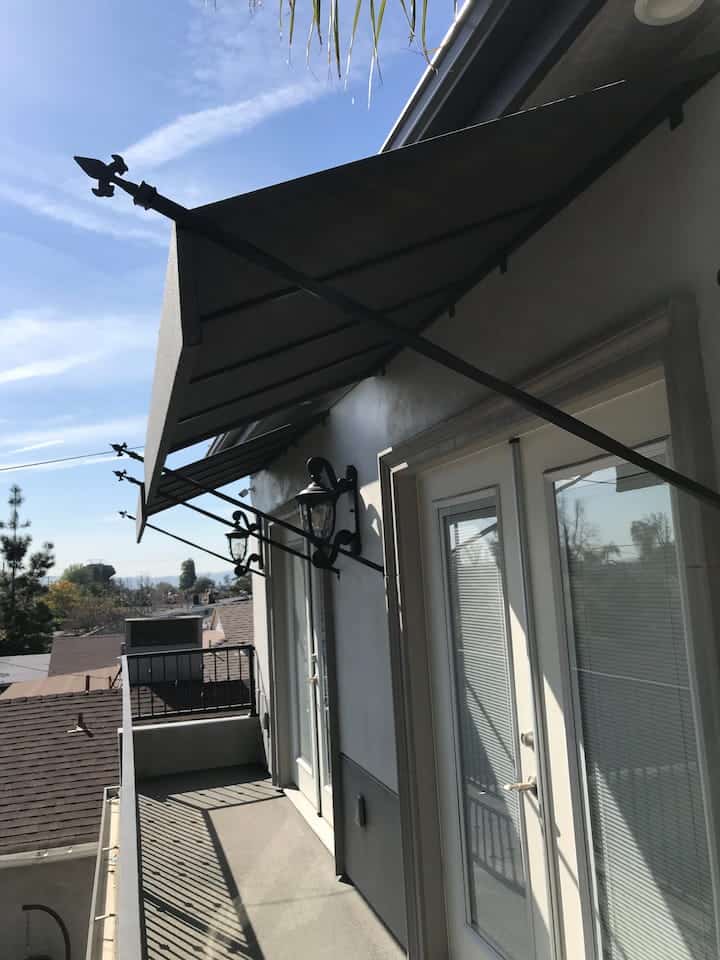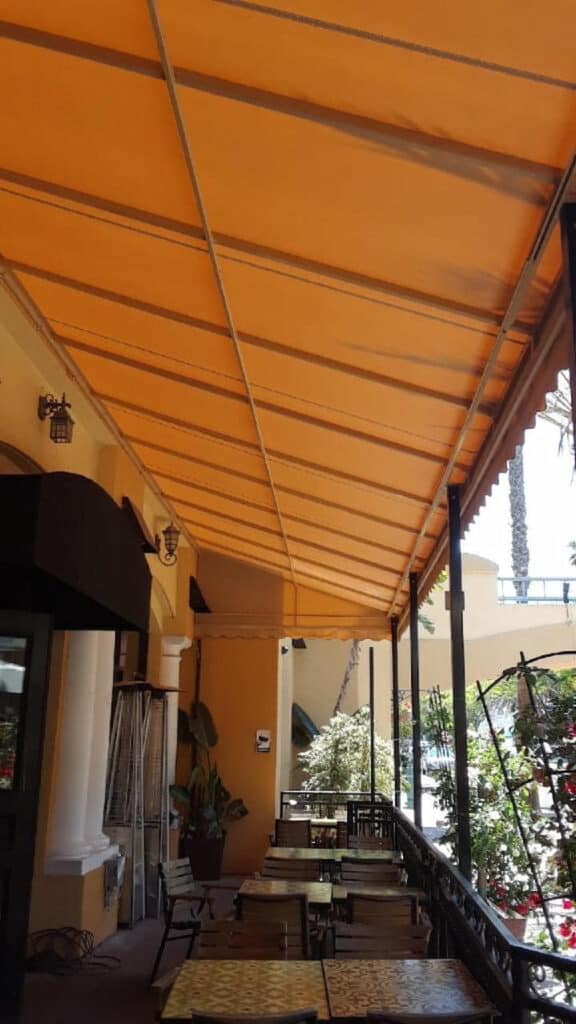What is an Awning? 13 August, 2022 – Posted in: All Services, Posts
What is an Awning?
An awning is a covering that is attached to the exterior of a building, most awnings are made of canvas or vinyl and are supported by a metal or wood framework.
They can also add a decorative touch to a building’s facade. While awnings were once mostly found on commercial buildings, they are now also commonly used on homes and RVs.
Awnings can provide shelter from the elements for both people and possessions. They can also be used to create outdoor living spaces, such as patios and decks.
In addition, awnings can be an energy-efficient way to cool your home or business, as they block out sun rays and reduce the need for air conditioning. They are available in a variety of styles, colors, and materials. Some are fixed in place, while others can be retracted or folded when not in use.
Types of Awnings
There are three types of awnings:
Fixed awnings
A fixed awning is attached to the exterior of a building and cannot be retracted or folded. It’s usually installed over a door or window and is used to protect against sun, wind, and rain.
Retractable awnings
A retractable awning can be retracted or folded when not in use. There are a variety of retractable models available, from manual to automatic, and they can be operated using a remote control or a mobile app. They are a great way to add shade to outdoor seating areas, and they can also be used to reduce the amount of bright sunlight that enters a home or office.
Portable awnings
A portable awning is not attached to the exterior of a building and can be moved as needed. Portable awnings are typically used for temporary protection from sun, wind, and rain.
Patio awnings
A patio awning is a type of retractable awning that is specifically designed for use on patios and decks.
Metal awnings
Some types of metal used to make awnings include aluminum and steel. While easy to install, aluminum awnings also provide a light structure. Steel awnings are more heavy-duty and are often used in commercial settings.
Freestanding awnings
A freestanding awning is a type of portable awning that is not attached to the exterior of a building. Freestanding awnings are popular for use in outdoor settings, such as camping, picnicking, and tailgating.
Window and door awnings
Awnings are a great way to add style and character to your home, while also providing protection from the elements.
Door awnings can provide shade on hot days and shelter from rain and snow, while window awnings can help to keep your home cooler in summer and warmer in winter.
Awnings are available in a wide range of styles, materials, and colors, so it’s easy to find an option that compliments your home’s existing architecture.
Benefits of Awnings
Awnings are a great addition to any home.
Not only do they provide protection from the sun, wind, and rain, but they also offer added privacy and reduced energy costs.
Awnings can keep your home cooler in the summer by blocking out the hot sun, and they can help to protect your furniture and flooring from fading.
In addition, awnings can help to reduce your air conditioning costs by keeping your home cooler.
Different Uses
Awnings can be used for a variety of purposes, including:
Shading your windows and doors to prevent heat from entering your home and help to reduce your air conditioner usage. This can lead to lower energy bills and cooler temperatures inside your home.
Awnings can also make your home more comfortable by blocking out the sun’s glare and UV rays.
They also create a stylish and inviting outdoor space, perfect for entertaining or simply relaxing in the shade.
Additional Customization Opportunities
Awnings are a great way to improve the look and functionality of your home, and there are a number of additional customization opportunities available, including:
- Choosing a style that complements your home’s existing architecture
- Selecting a color that matches your home’s décor
- Choosing a material that withstands inclement weather conditions
- Adding LED lights for both practical illumination and a stylish accent
Awning Installation
Installation of an awning typically involves attaching the awning to the exterior of a building. However, portable awnings can be moved as needed, which makes them a popular choice for temporary protection from sun, wind, and rain.
When selecting an awning for your home, it’s important to consider the size, style, and function of the awning, as well as your budget.
Awning Maintenance
Awning fabric should be cleaned regularly to remove dirt, dust, and pollen. A mild soap and water solution can be used for most types of awning fabric. Awnings should be inspected regularly for signs of wear and tear, such as rips, tears, or fraying. Any damaged parts should be repaired or replaced as soon as possible to avoid further damage.
Motors and frames should also be inspected regularly for signs of wear and tear. Motors should be lubricated according to the manufacturer’s instructions, and any damaged or broken parts should be repaired or replaced.
If you’re looking for high-quality awnings that will provide years of enjoyment, ESA Awnings is the company for you. We specialize in manufacturing, selling, and installing custom awnings, and we’re proud to offer a 10 year guarantee on all of our products.
With over 100 colors to choose from, we have the perfect shade to match your home or business. At ESA Awnings, we take great pride in our workmanship and only use top-quality materials, so you can be confident your awning will be a perfect fit. Call us today for a free estimate, and see why ESA Awnings is the best choice for all your awning needs.
FAQ
What is the Difference Between an Awning and a Canopy?
Awnings and canopies are both types of outdoor coverings that can provide shade and protection from the elements. However, there are some key differences between the two.
An awning is typically attached to the exterior wall of a building, and it has a sharp angle that allows it to deflect sunlight.
A canopy, on the other hand, is a freestanding structure and often has a more rounded shape.
 (323) 441-0108
(323) 441-0108

